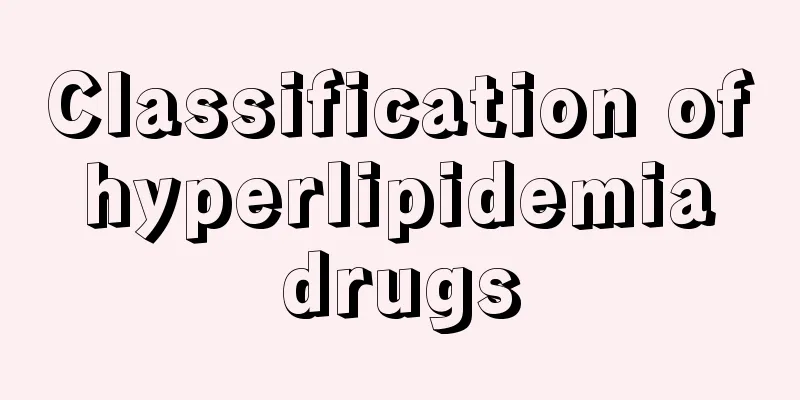Classification of hyperlipidemia drugs

|
Many people may not be aware of the harm that high blood lipids bring to the human body. In fact, many diseases in the elderly are caused by high blood lipids. For example, the most serious disease, hypertension, may be closely related to high blood lipids. Moreover, the most direct disease caused by high blood lipids is cerebral infarction caused by atherosclerosis. When the elderly find that they have high blood lipids, what drugs can be used to treat it? 1. Lipid-lowering drugs Lipid-lowering drugs are drugs that lower blood lipid levels. Blood lipids are the general term for neutral fats (triglycerides and cholesterol) and lipids (phospholipids, lipids, sterols, steroids) in plasma, and are widely present in the human body. They are essential substances for the basic metabolism of living cells. Generally speaking, the main components of blood lipids are triglycerides and cholesterol. 2. Five major categories of lipid-lowering drugs 1. Statins Statins are trimethylglutaryl coenzyme A (HMG-CoA) reductase inhibitors, also known as cholesterol biosynthesis enzyme inhibitors. They are the rate-limiting enzyme for cholesterol synthesis in cells and are currently the most widely used class of lipid-lowering drugs in clinical practice. Since the English names of these drugs all contain "statin", they are often referred to as statins. There are currently five types of statins available for clinical use: (1) atorvastatin, commonly used drugs are Pfizer's Lipitor and Alpha; (2) lovastatin, commonly used drugs are Meclizine, Rovanin, Loto, Lozhite, etc., and the main ingredient of Xuezhikang is also lovastatin; (3) simvastatin, commonly used drugs are Zocor, Risode, Jingbishuxin, Zezhihao, Suzhi, Xinke, etc.; (4) pravastatin, commonly used drugs are Pravastatin and Meperidine; (5) fluvastatin, commonly used drugs are Lescol. The most common adverse reactions to this type of drug are mild gastrointestinal reactions and headaches. Myotoxicity may occur when used in combination with other lipid-lowering drugs. 2. Fibrates The main indications of fibrates are: hypertriglyceridemia or mixed hyperlipidemia with elevated triglycerides as the main feature. The fibrate drugs currently used in clinical practice mainly include ciprofibrate, bezafibrate, fenofibrate and gemfibrozil. According to clinical practice, these drugs can effectively reduce triglycerides by 22% to 43%, while reducing TC by only 6% to 15%, and have the effect of increasing high-density lipoprotein to varying degrees. Common adverse reactions of this drug include gastrointestinal reactions, nausea, and diarrhea, and severe cases can cause liver damage. 3. Niacin Niacin drugs belong to the B vitamins. When the dosage exceeds the dose of their vitamin function, they can have a significant lipid-lowering effect. This type of drug has a wide range of applications and can be used for any type of hyperlipidemia except homozygous familial hypercholesterolemia and type I hyperlipoproteinemia. However, the immediate-release formulation of this drug has serious adverse reactions, so we generally do not use it alone. The medical community is still unclear about the lipid-lowering mechanism of niacin. Sustained-release preparations significantly reduce redness, mainly facial flushing. 4. Bile acid chelators These drugs are also called bile acid sequestrants. There is Cholestyramine, and commonly used drugs include colestyl. Common adverse reactions of this drug include gastrointestinal reactions, nausea, constipation or diarrhea, intestinal obstruction or headache, etc. 5. Cholesterol absorption inhibitors This type of drug mainly achieves the purpose of lowering blood lipids by inhibiting the absorption of cholesterol in the intestine and bile. Currently, there are very few drugs of this type on the market. 3. Seal oil effectively lowers blood lipids Seal oil is rich in nutrients such as EPA, DHA, DPA, etc., which can help lower blood lipids and soften blood vessels. It promotes and improves the body's immunity, enhances memory, has anti-cancer and anti-cancer and beauty effects, and has many benefits to human health. |
<<: Chinese medicine prescription for hyperlipidemia
>>: Recipe for regulating high blood lipids
Recommend
The difference between kale and cabbage
Cabbage and kale are actually the same kind of di...
Characteristics of shoulder pain caused by lung cancer
Shoulder pain from lung cancer is usually related...
How to Cover Gray Hair
Some people don't want to dye their hair when...
Daily treatment measures for intermittent headaches
Some people often suffer from headaches, and they...
Common nursing measures for gastric cancer
The most important thing for gastric cancer patie...
How to improve metabolism after dieting
Nowadays, people choose many ways and methods to ...
The process of untying the ligature
Sterilization is a very common method of contrace...
How to promote blood circulation in the legs
If the blood in our legs cannot circulate, then t...
Filter coffee
Many people love drinking coffee, especially when...
What are the precautions for hyperthyroidism in life?
Hyperthyroidism is a relatively common thyroid di...
What does twitch mean
There are many common problems in life, and diffe...
What are the wonderful uses of white vinegar
White vinegar, a common condiment in our lives, c...
How to prevent bronchial lung cancer
In recent years, the harm of bronchial cancer has...
What to do if a child has lymph nodes
Many parents are very attentive when taking care ...
Is hyperplastic anemia serious?
Generally speaking, under normal circumstances, t...









